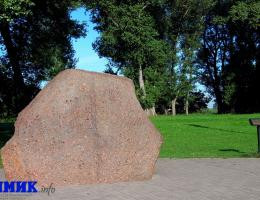Shield with mistakes installed at Barys’ Stone in Polatsk
9- 5.09.2014, 9:12
- 10,535

The information, given in the shield that has been installed next to Barys’ Stone in Polatsk, contains a number of inaccuracies.
In early November last year shield were installed next to the city’s historical, cultural and architectural monuments with a short description. Such a shield was installed at Barys’ Stone, located on the hill next to the Sofiya Church. Although, the information, provided on it, contains a number of inaccuracies. The Khimik learnt that from a historian Ihar Zalilau:
“Do not trust your own eyes – these words from a well-known aphorism by Kozma Prutkov came up in memory when I examined Barys’ Stone – Belarus’ monumental memorial dating back to first half of XII century, located near the Sofiya Church in Polatsk. Up until now I was sure that the cross, carved on its surface in those distant times was four-ended. However, the text on the information board, place next to the stone, despite the obvious evidence, claims that it is six-ended. I once again examined the original of the image on the stone – the cross is four-ended with its base place on an three-level pedestal – Golgotha. But on the shield I read that it is six-ended. I keep reading and learn to my surprise that, according to the authors of the text, the village of Padkasciolcy, where this stone lied for many centuries, is located on the right bank of the Western Dzvina river. I look to the west along the flow of the river, and get relieved to find out that, even having been joined to Navapolatsk, the village of Padkasciolcy remained at its age-old site – the southern, left bank of the Western Dzvina river.
Further from the text we learn that the bedrock of the stone is feldspar. However, in 1981, before the stone was lifted from the bed of the river, I made a request to identify the stone’s geology nature to the Institute for Geo-Chemistry and Geo-Physics of the Academy of Sciences of BSSR. The response to the request stated that the bedrock was identified as granite rapakivi, which, translated from Finnish, means “rotten stone”. The origin of this bedrock is the Vyborg mountain mass in the north of Leningrad region. The document must be stored in the archive. Feldspar is only one of the components among mica, quartz, hornblende and other components, which together constitute the type of granite”, - the historian says.









